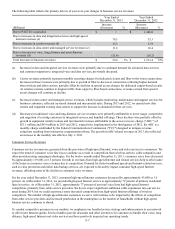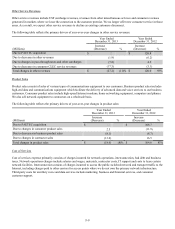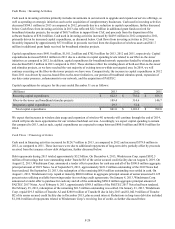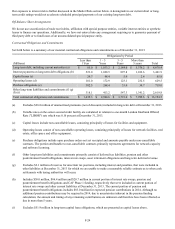Windstream 2013 Annual Report Download - page 152
Download and view the complete annual report
Please find page 152 of the 2013 Windstream annual report below. You can navigate through the pages in the report by either clicking on the pages listed below, or by using the keyword search tool below to find specific information within the annual report.
F-16
Discontinued Operations, net of tax
On December 5, 2013, we completed the sale of Pinnacle, a software business acquired as part of PAETEC, which provided
comprehensive solutions for supporting the full lifecycle of information technology and telecommunications services. On June
15, 2012, we completed the sale of the energy business also acquired as part of PAETEC, which sold electricity to business and
residential customers, primarily in certain geographic regions in New York state, as a competitive electricity supplier. The
operating results of the software and energy businesses have been separately presented as discontinued operations in the
accompanying consolidated statements of income. See Note 15 to the consolidated financial statements for additional
information.
Regulatory Matters
We are subject to regulatory oversight by the FCC for particular interstate matters and state public utility commissions
("PUCs") for certain intrastate matters. We are also subject to various federal and state statutes that direct such regulations. We
actively monitor and participate in proceedings at the FCC and PUCs and engage federal and state legislatures on matters of
importance to us.
From time to time federal and state legislation is introduced dealing with various matters that could affect our business. Most
proposed legislation of this type never becomes law. Accordingly, it is difficult to predict what kind of legislation, if any, may
be introduced and ultimately become law.
Federal Regulation and Legislation
Intercarrier Compensation and USF Reform
On November 18, 2011, the FCC released an order ("the Order") that established a framework for reform of the intercarrier
compensation system and the federal USF. The Order included two primary provisions:
• the elimination of terminating switched access rates and other per-minute terminating charges between service
providers by 2018, through annual reductions in the rates, mitigated in some cases by two recovery mechanisms; and
• the provision of USF support for voice and broadband services.
In reforming the USF, the Order established the Connect America Fund ("CAF"), which included a short-term ("CAF Phase 1")
and a longer-term ("CAF Phase 2") framework. CAF Phase 1 provides for continued legacy USF funding frozen at 2011 levels
as well as the opportunity for incremental broadband funding to a number of unserved and underserved locations. CAF Phase 1,
Round 1, incremental broadband support was limited to $775 per unserved location in 2012. On July 24, 2012, we elected to
accept approximately $0.7 million of the $60.4 million in incremental support allocated to us for 2012. As a result of our
aggressive broadband deployment to date, we had very few unserved locations remaining in our service areas for which $775 in
incremental support would have made broadband deployment economical. The FCC, however, approved our supported
modifications to the rules governing CAF Phase 1, Round 2, incremental support. As a result, we now have been authorized to
receive an additional $75.2 million in incremental support for upgrades and new deployments of broadband service. We may
elect to receive more funding to deploy to additional locations in census blocks that have been deemed eligible to receive CAF
Phase 1 support. Of the total amount of $75.2 million made available to us, we received $60.7 million in December 2013 and
the remaining $14.5 million in January 2014. Pursuant to commitments we made while the FCC was considering the rules for
Round 2, we will match, on at least a dollar-for-dollar basis, the total amount of Round 2 funding we receive.
The FCC is currently working to establish rules for CAF Phase 2 funding based on a forward-looking cost model to further
extend broadband to high-cost areas. Until the implementation of CAF Phase 2 is complete, the annual "legacy" USF funding
will continue to be frozen at 2011 levels. We were required to use one-third of the frozen legacy support to operate and build
broadband networks in areas substantially unserved by an unsubsidized competitor in 2013. In 2014, this condition will apply
to two-thirds of the frozen legacy support, and in 2015 it would increase to 100 percent. Our expectation is that our legacy
federal USF support will continue to be approximately the same until CAF Phase 2 is implemented.
























